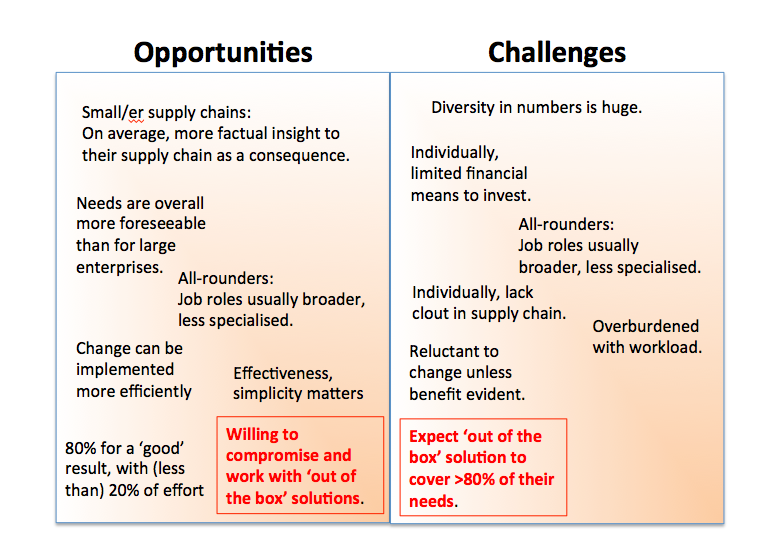
This article appeared it edited format in Ecotextile News April/May 2015 edition.
An earlier Shirahime article on the topic of SMEs, appeared under the title ‘80 : 20, 20 : 80: Impact of SMEs vs. Corporates‘ in 2013.
The last decade has moved our industry considerably along in sustainability terms. Standards have been written and are being implemented, measurement tools devised, and even policy written into law.
Large corporations now habitually report on their sustainability achievements, have resource efficiency programmes firmly implemented into their operations, and are investing to make their enterprises ‘future proof’.
Yet, looking at the vast ‘rest’ of our economies, the very ordinary so called ‘mainstream’, nothing much seems to have tangibly moved. Well, other than some high-profile best practice cases being published, and equally high-profile milestone laws written (REACh, for one).
Given this ‘stale mate’ situation, the question that arises is: why this lack of dynamic overall? Are we addressing the right target public and business case with the above mentioned tools, policies, methodologies?
‘Usual Targets’ = ‘Usual Suspects’ – Large enterprises.
Looking at
- the typical member and/or signatory of initiatives such as the Sustainable Apparel Coalition (SAC), Zero Discharge of Hazardous Chemicals (ZDHC), Ethical Trade Initiative (ETI), the Bangladesh Accord (BA), the Global Reporting Initiative (GRI), the Global Compact (GC), the Ellen McArthur Foundation (EMF), or the Natural Capital Coalition (NCC), and
- limiting our analysis to members that are actors in textile/fashion industry,
a clear bias towards large to very large (multi-national) enterprises becomes apparent..
What is critical: these are enterprises that – across all sectors – only amount to 0.2% (in numbers) of all enterprises in the EU.
Drawing from the same EU statistics however, gives us the fundamental reason why it is always and invariably the (same) large enterprises that target for, and hence become part of such initiatives. Fundamentally, it boils down to a simplified version of the famous ’80:20’ rule:
While a scarce 0.2% of enterprises are large to very large enterprises – meaning: they are very few and far between – they employ around 33% of the working population, and generate nearly 42% of the value added to our economies. Which of course means they – on average – provide the ‘largest bang for the buck’ for any of the above-mentioned initiatives.
The unfortunate side effect of such a thinking though is that as good as all the tools, methodologies, protocols etc. that have been developed in the past decade are usually not suitable to the remaining 99.8% of enterprises, who still represent–as a collective –67% of the working population and 58% if the value generated in our economies. The tools in fact have typically become too large, too multi-facetted, too expensive to apply. The results offer a fairly reasonable degree of accuracy – at the cost of not offering results that help to assess the bigger picture and primary priorities.
It’s a case of ceasing to see the wood for all the trees.

Mind the gap
The SMEs collective is a real economic and impact driver:
Small and Medium Enterprises (SMEs) are – contrary to common perception – the backbone of every single economy on earth. As mentioned above, they represent in Europe alone, a staggering 99.8% (inn numbers) of all enterprises, which translate to giving employment to 67% of all workers, and add 58% of all the value added across the EU. Similar figures can be found for the US and Canada, and if we were to look further overseas at Asia, Africa or South America the numbers would become much more drastic still.
To spell out what this means:
For any type of effort where scale and impact is needed and the ultimate goal SMEs are – as a collective – more important to our economies than large enterprises.
Of course this consequently applies also, and possibly with even more urgency, to any discussion about sustainability, environmental and social impact.
SMEs may be large in numbers, and – at least on first sight – diverse in character. This often then leads to the assumption that they are a difficult to deal with target audience as a collective, and unprofitable as individual entity.
Which leads to the question: Is that indeed so? And: what are the opportunities that sure must exists to at least balance the challenges?
Figure 1 summarises some of the challenges, but also points out some of the more important opportunities that SMEs offer.

In the above illustration, which admittedly only summarises the most important challenges and opportunities, one of the key characteristics of SMEs is highlighted in red for both areas:
SMEs, fully aware of the challenge their size and the diversity represented through their number offers, are highly likely to accept, and hence use, ‘out of the box solutions’ for just about anything – from accounting to supply chain management and HR – including sustainability standards and measurement tools. As long as the majority of their needs are covered, and – important – that these tools make effective and efficient use of the limited (time) resources they have.
And here lies the issue with tools such as those mentioned in the previous section, that have been developed by, and hence primarily for, organisations with predominantly large corporations as members: they are not likely to offer an ‘out of the box solution’ but rather one that is ‘customisable’. Think Microsoft Excel on the one hand, and an SAP system on the other.
Tools of the trade
Remember that Pepsi Co slogan: “Reduce to the max!”?
When targeting SMEs this is exactly what it is all about. Applied to the landscape of sustainability tools, this would translate to something akin to the following:
- Which are the 25 most important questions of the Higg Index (environmental facility and brand module) that help a company’s continuing improvement process and provide highly valuable data points to a company?
- What are the 10 most important points in the ZDHC Audit protocol, that are both straight forward to understand and equally highly representative of a company’s chemical management capabilities?
- Which 12 questions of the Fair Wear Foundations social benchmarking tool are the most likely to point out fundamental weakness and development areas in a supplier, independently of geography?
In other words: there is nothing wrong with these tools offering a high degree of sophistication for those that needs and desire it.
But – talking of not seeing the wood for the trees – while a tool not only lives or dies with its upward scalability, downward scalability is just as relevant. Application to SMEs thereby is the lesser issue, although of evident importance for statistical reasons as explained above. However, if the creators of any one tool cannot spell out and identify the most critical questions, points, areas of their tool, there is a suspicion that it is an approach that may ultimately die a ‘death by perfection’ for lack of focus, and excess in depth.
Some organisations, such as the British Standards Institute have created guidelines and packages to guide SMEs towards the use of ISO standards in particular. Examples are ISO 140001 (environmental management) or ISO 9001 (quality management). Even the European Union again as created a 12 page ‘awareness raising questionnaire’ with a total of 26 questions and including guidance, to help SMEs reflect on their sustainability-related credentials and activities; and the Global Reporting Initiative (GRI) as issued special guidance to help SMEs to report against their framework.
And also more recent developments at the Sustainability Apparel Coalition, specifically: the Design and Development Module for the Proto1 design stage, point towards a development whereby priorities and target audience are sharply defined.
So, what needs to happen
with existing tools?
The resources invested in existing tools,
such as the Higg Index or the ZDHC audit protocol are all but lost.
However, the development process is not finished yet, and we need to take a step backwards and slow down to think and sharpen the focus. Because, what is missing for all of these tools is the equivalent of the most important part of any scientific article: The conclusion chapter – the elevator pitch of any scientific publication.
Conclusion: The power of the elevator pitch
SMEs are, and will likely remain, the principle backbone of the European – as well as global – economy. This means that in sustainability terms they represent, as a collective, the largest opportunity to make change truly happen. At the same time they also are a highly critical audience and push back on any measure with ‘fuzzy’ aspects, be it in effort required or outcome offered.
Rather than to ignore such a large pool of companies for their size and the sheer diversity hidden behind their numbers, we should look at what their most important requirement is: tools and measures that represent the most focused and effective use of their time and resources. They may not be perfect, and they may not go into the hidden crannies of their operations. But in 80% of what they do cover, they do it well, efficiently, accurately, and highly usable.
With this attitude, they have turned their individual structural weakness – size, clout, and financial means – into a critical strength of the collective. A strength we cannot do without if real impact is what we’re after.

